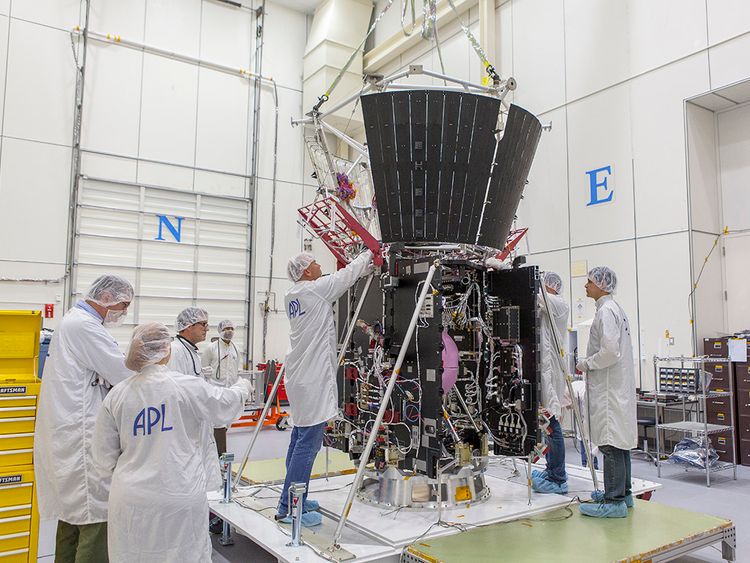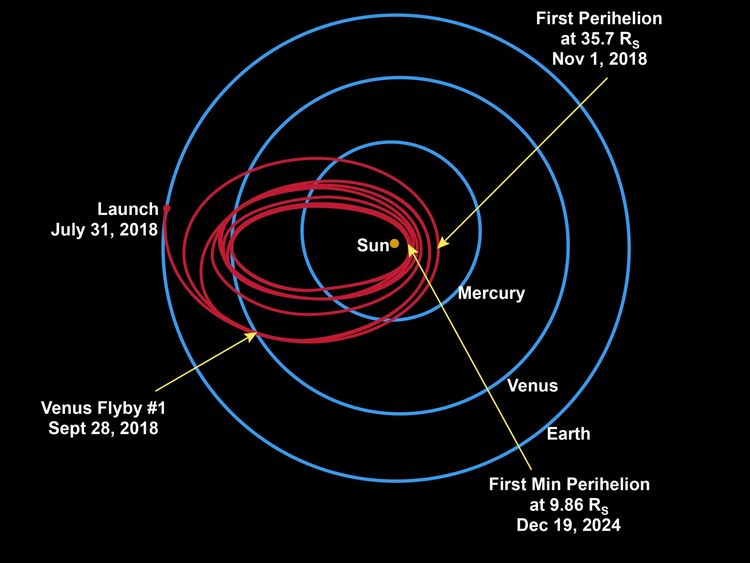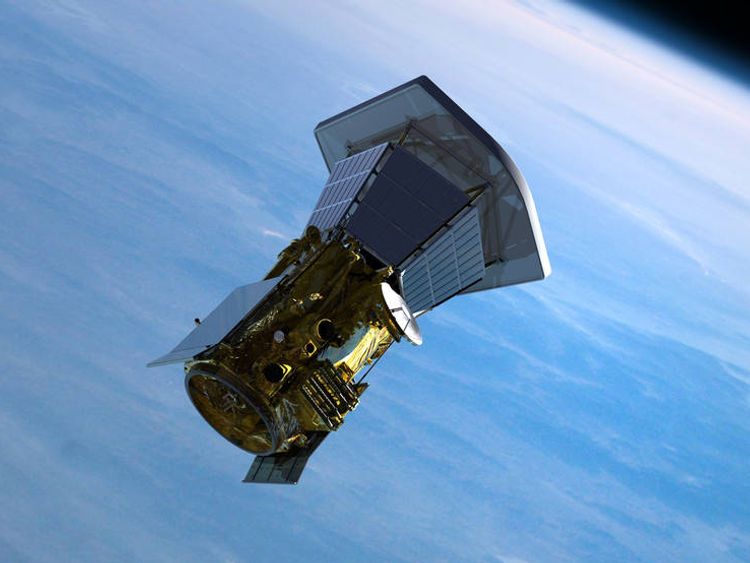NASA has delayed the launch of a probe which will make a series of unprecedented orbits of the sun.
The probe was scheduled to take off from Florida's Cape Canaveral at 9.28am UK time, but just one minute and 55 seconds before launch it was cancelled after a technical fault.
The launch of the probe, which will be carried on the back of a United Launch Alliance Delta IV Heavy rocket, is now scheduled to take place on Sunday morning.
Thousands of people had gathered at Cape Canaveral to watch the take-off, which was initially due to take place at 4.38am local time.
Among them was Eugene Parker, the University of Chicago astrophysicist for whom the spacecraft is named.
As the Parker Solar Probe probe orbits the sun, it will experience extreme radiation and temperatures as high as 1,377C (2,510F) – close to the melting point of steel.
To handle the heat it has been covered with a special 4.5 inch (11.3 cm) thick carbon-composite shield capable of withstanding temperatures up to 1,650C (3,002F).
It will get more than seven times closer than the current record holder for a close solar pass, a record set by the Helios 2 spacecraft in 1976.
"The primary science goals for the mission are to trace how energy and heat move through the solar corona and to explore what accelerates the solar wind as well as solar energetic particles," explained NASA.
"Scientists have sought these answers for more than 60 years, but the investigation requires sending a probe right through the 2,500 degrees Fahrenheit heat of the corona.
"Today, this is finally possible with cutting-edge thermal engineering advances that can protect the mission on its dangerous journey.
"Parker Solar Probe will carry four instrument suites designed to study magnetic fields, plasma and energetic particles, and image the solar wind."

After it launches, the probe will travel at 430,000mph, the fastest speed ever achieved by a spacecraft.
NASA stated: "Parker Solar Probe will provide unprecedented information about our sun, where changing conditions can spread out into the solar system to affect Earth and other worlds."
The probe is going to fly directly into the sun's atmosphere and trace the movement of energy and heat with the particles that form solar winds.
It will take six years to reach its closest point to the sun, in 2024, by using Venus' gravity to bring itself nearer to the star.

The probe will help scientists understand more about the nature of the sun by taking measurements of solar winds, a flow of ionised gases.
If scientists understand more about solar activity, they could use it to predict large solar eruptions that pose a threat to satellites orbiting the Earth.
Scientists also hope the probe can help them to answer why the corona, the outermost layer of the sun's atmosphere, is 300 times hotter than its surface.

This is a phenomenon that has baffled NASA scientists because the sun's atmosphere "gets much, much hotter the farther it stretches from the sun's blazing surface".
More from Science & Tech
The probe will be controlled from the Mission Operations Centre based at the Johns Hopkins University Applied Physics Laboratory (JHU APL), which is where NASA handles its unmanned missions.
Manned missions, such as the Apollo moon landings, were run from the Christopher C Kraft Mission Control Centre in Houston, from where it earned its famous radio call sign.
NASA has delayed the launch of a probe which will make a series of unprecedented orbits of the sun.
The probe was scheduled to take off from Florida's Cape Canaveral at 9.28am UK time, but just one minute and 55 seconds before launch it was cancelled after a technical fault.
The launch of the probe, which will be carried on the back of a United Launch Alliance Delta IV Heavy rocket, is now scheduled to take place on Sunday morning.
Thousands of people had gathered at Cape Canaveral to watch the take-off, which was initially due to take place at 4.38am local time.
Among them was Eugene Parker, the University of Chicago astrophysicist for whom the spacecraft is named.
As the Parker Solar Probe probe orbits the sun, it will experience extreme radiation and temperatures as high as 1,377C (2,510F) – close to the melting point of steel.
To handle the heat it has been covered with a special 4.5 inch (11.3 cm) thick carbon-composite shield capable of withstanding temperatures up to 1,650C (3,002F).
It will get more than seven times closer than the current record holder for a close solar pass, a record set by the Helios 2 spacecraft in 1976.
"The primary science goals for the mission are to trace how energy and heat move through the solar corona and to explore what accelerates the solar wind as well as solar energetic particles," explained NASA.
"Scientists have sought these answers for more than 60 years, but the investigation requires sending a probe right through the 2,500 degrees Fahrenheit heat of the corona.
"Today, this is finally possible with cutting-edge thermal engineering advances that can protect the mission on its dangerous journey.
"Parker Solar Probe will carry four instrument suites designed to study magnetic fields, plasma and energetic particles, and image the solar wind."

After it launches, the probe will travel at 430,000mph, the fastest speed ever achieved by a spacecraft.
NASA stated: "Parker Solar Probe will provide unprecedented information about our sun, where changing conditions can spread out into the solar system to affect Earth and other worlds."
The probe is going to fly directly into the sun's atmosphere and trace the movement of energy and heat with the particles that form solar winds.
It will take six years to reach its closest point to the sun, in 2024, by using Venus' gravity to bring itself nearer to the star.

The probe will help scientists understand more about the nature of the sun by taking measurements of solar winds, a flow of ionised gases.
If scientists understand more about solar activity, they could use it to predict large solar eruptions that pose a threat to satellites orbiting the Earth.
Scientists also hope the probe can help them to answer why the corona, the outermost layer of the sun's atmosphere, is 300 times hotter than its surface.

This is a phenomenon that has baffled NASA scientists because the sun's atmosphere "gets much, much hotter the farther it stretches from the sun's blazing surface".
More from Science & Tech
The probe will be controlled from the Mission Operations Centre based at the Johns Hopkins University Applied Physics Laboratory (JHU APL), which is where NASA handles its unmanned missions.
Manned missions, such as the Apollo moon landings, were run from the Christopher C Kraft Mission Control Centre in Houston, from where it earned its famous radio call sign.











